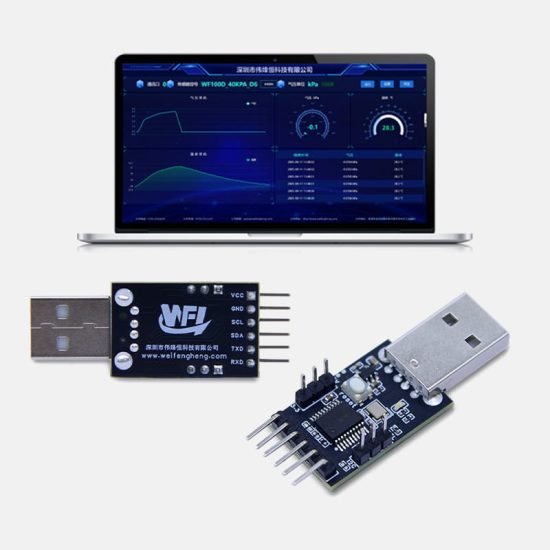목록
이 포괄적인 문서에서는 대기압 센서 교정 방법과 무선 센서의 장점을 다루고 있습니다. 교정에는 환경 안정성을 갖춘 사전 준비, 표준 기압계를 사용한 정적 교정, 다양한 조건에서의 동적 교정 및 자가 교정 기능이 포함됩니다. 무선 센서는 유연성, 실시간 데이터 전송, 쉬운 설치, 확장성, 환경 적응성, 데이터 통합, 에너지 효율성, 안전성, 비용 효율성 및 IoT 통합을 통한 향상된 모니터링 기능을 제공합니다.
1. 사전 교정 준비
교정을 수행하기 전에 센서가 안정적인 상태에 있고 환경 조건(예: 온도 및 습도)이 교정 요구 사항을 충족하는지 확인하는 것이 중요합니다. 또한 표준 기압계, 교정 소프트웨어, 연결 케이블 등 교정 장비도 준비해야 합니다. 압력 센서는 온도 변화에 매우 민감하므로 이 단계에서는 온도 보상이 중요합니다. 열 안정성을 보장하려면 적절한 예열 시간(일반적으로 30~60분)을 허용해야 합니다.
2. 정적 교정
정적 교정은 일반적으로 표준 기압계를 기준으로 사용하여 고정된 대기압 조건에서 수행됩니다. 절차에는 다음이 포함됩니다.
1단계: 대기압 센서와 표준 기압계를 동일한 환경에 배치하여 둘 다 동일한 압력 조건에 있는지 확인합니다.
2단계: 표준 기압계의 판독값을 기록합니다.
3단계: 압력 센서 판독값을 표준 기압계 판독값과 비교하고 편차를 계산합니다.
4단계: 판독값이 표준 기압계와 일치할 때까지 편차를 기반으로 센서의 교정 매개변수를 조정합니다. 전체 측정 스펙트럼에 걸쳐 선형성과 정확성을 보장하려면 센서 작동 범위의 여러 측정 지점을 테스트해야 합니다.
3. 동적 교정
실제 작동 환경을 시뮬레이션하기 위해 다양한 압력 조건에서 동적 교정이 수행됩니다. 단계는 다음과 같습니다.
1단계: 압력 챔버와 같이 압력 변화를 제어할 수 있는 환경에 대기압 센서를 배치합니다.
2단계: 압력실의 압력을 점차적으로 변경하고 압력 센서와 표준 기압계의 판독값을 기록합니다.
3단계: 데이터를 분석하여 다양한 압력 조건에서 센서의 반응 특성을 결정합니다.
4단계: 동적 교정 결과에 따라 센서의 동적 교정 매개변수를 조정합니다. 센서 반응의 시스템적 오류를 식별하기 위해 압력 상승 및 하강 사이클을 모두 수행하여 히스테리시스 효과를 평가해야 합니다.
4. 자체 교정
일부 최신 대기압 센서에는 자동으로 교정을 수행할 수 있는 자체 교정 기능이 있습니다. 단계는 다음과 같습니다.
1단계: 센서의 자체 교정 프로그램을 시작합니다.
2단계: 센서는 측정 정확도를 보장하기 위해 내부 매개변수를 자동으로 조정합니다.
3단계: 오류가 발생하지 않도록 자체 교정 프로세스를 모니터링합니다. 고급 센서에는 기계 학습 알고리즘이 통합되어 과거 데이터와 환경 패턴을 기반으로 교정 정확도를 지속적으로 향상할 수 있습니다.
5. 정기 교정
측정 정확도를 유지하려면 대기압 센서를 정기적으로 교정하는 것이 좋습니다. 교정 간격은 센서 사양, 환경 조건 및 애플리케이션 중요도에 따라 결정되어야 합니다. 고정밀 응용 분야에는 월별 교정이 필요할 수 있지만 표준 응용 분야에서는 연간 교정 일정으로 충분할 수 있습니다.
무선 대기압 센서의 장점
1. 유연성과 이식성
무선 기압 센서는 데이터 로거나 모니터링 시스템에 물리적으로 연결할 필요가 없으므로 특히 배선이 까다로운 환경에서 다양한 위치에 쉽게 배포할 수 있습니다.
2. 실시간 데이터 전송
무선 기압 센서는 실시간으로 데이터를 전송할 수 있으며 이는 즉각적인 대응이 필요한 애플리케이션(예: 기상 모니터링 및 재난 경고 시스템)에 매우 중요합니다.
3. 간편한 설치 및 유지관리
배선이 필요하지 않으므로 무선 기압 센서의 설치 및 유지 관리 작업량이 최소화되어 비용과 복잡성이 줄어듭니다.
4. 확장성
무선 네트워크를 사용하면 더 많은 센서 노드를 쉽게 추가할 수 있어 모니터링 네트워크 확장이 용이합니다.
5. 환경 적응성
무선 대기압 센서는 일반적으로 열악한 환경 조건에 적응할 수 있도록 더욱 견고하고 내구성이 뛰어나도록 설계되었습니다.
6. 데이터 공유 및 통합
무선 센서는 기존 데이터 관리 시스템 또는 클라우드 플랫폼과 쉽게 통합되어 중앙 집중식 데이터 관리 및 분석이 가능합니다.
7. 에너지 효율성
많은 무선 대기압 센서는 저전력 설계를 채택하고 배터리 전원으로 작동할 수 있어 장기간 배포에 적합합니다.
8. 안전
무선 센서는 현장 배선의 필요성을 줄여 전기 안전 위험을 낮춥니다. 많은 무선 기압 센서는 저전력 설계를 채택하고 배터리 전원으로 작동할 수 있어 장기간 배포에 적합합니다.
9. 비용 효율성
초기 투자 비용은 높을 수 있지만 무선 센서는 배선 및 유지 관리 비용을 줄여 장기적으로 더 나은 비용 효율성을 제공할 수 있습니다.
10. 환경 모니터링
환경 모니터링 애플리케이션의 무선 대기압 센서는 더 넓은 데이터 범위를 제공하여 환경 변화를 더 잘 이해하고 예측하는 데 도움이 됩니다.
11. 향상된 네트워크 안정성
Modern wireless pressure sensors often incorporate mesh networking capabilities, ensuring data transmission continuity even if individual nodes fail. This redundancy significantly improves overall system reliability and reduces data loss risks.
12. 고급 데이터 분석
무선 센서는 클라우드 컴퓨팅 플랫폼을 통해 정교한 데이터 분석을 가능하게 하여 잠재적인 문제가 심각해지기 전에 이를 식별할 수 있는 예측 유지 관리, 추세 분석 및 자동화된 경고 시스템을 가능하게 합니다.
결론
대기압 센서의 교정은 측정 데이터의 정확성을 보장하는 데 중요합니다. 올바른 교정 방법을 채택하면 센서 성능과 신뢰성이 향상될 수 있습니다. 유연성, 실시간 기능 및 배포 용이성을 갖춘 무선 기압 센서는 현대 모니터링 시스템에서 점점 더 중요한 역할을 하고 있습니다. 사물 인터넷(IoT) 기술이 계속 발전함에 따라 무선 압력 센서는 스마트 시티 인프라의 필수 구성 요소가 되어 포괄적인 환경 모니터링을 가능하게 하고 지속 가능한 도시 개발에 기여합니다. 기술 발전에 따라 무선 기압 센서의 적용 범위는 더욱 확대되어 다양한 산업 분야에 보다 효율적이고 정확한 모니터링 솔루션을 제공할 것입니다.
위의 소개는 압력 센서 기술 적용의 표면적인 부분에 불과합니다. 우리는 다양한 제품에 사용되는 다양한 유형의 센서 요소, 작동 방식, 장점과 단점을 계속해서 탐구할 것입니다. 여기에서 논의된 내용에 대해 더 자세히 알아보려면 이 가이드 뒷부분의 관련 콘텐츠를 확인하세요. 시간이 촉박한 경우 여기를 클릭하여 이 가이드의 세부정보를 다운로드할 수도 있습니다. 공기 압력 센서 제품 PDF 데이터.
다른 센서 기술에 대한 자세한 내용은 다음을 참조하십시오. 센서 페이지를 방문하십시오.


